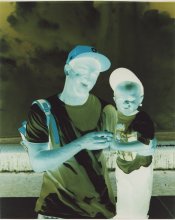I once spend a day in my darkroom doing exactly that after thinking about the internegative process a day before. Basically, RPC's assumptions are spot on. Contrast is very high, I had to work with the lowest grade possible on Ilford MG IV RC paper. Also, the coloration of the slide interacts with the contrast sensitivity of the multigrade paper, creating color-dependend local contrast differences, which adds to the fact that this process does not take care of a proper transition of colors to greyscale in the first place.
Lastly, despite placing a glass plate onto the "interneg-paper" and the target paper, the final image was soft compared to the interneg-paper. If it is just about the image and keeping it in the darkroom, this process can deliver. But it is way off what a proper negative print can look like in terms of sharpness and tones; it doesn't do justice to a well exposed and composed slide, too.
I still intent to try out b/w interneg film for reproducing color slides on b/w paper. b/w film can surely cope with the dynamic range at hand in this process and is easily developed in a short time. I still have some sheets of old AGFA APX 100 in 4x5 that I want to try out as an interneg for 6x7 slides.













